warning VOLVO S40 2006 Service Manual
[x] Cancel search | Manufacturer: VOLVO, Model Year: 2006, Model line: S40, Model: VOLVO S40 2006Pages: 127, PDF Size: 2.26 MB
Page 96 of 127
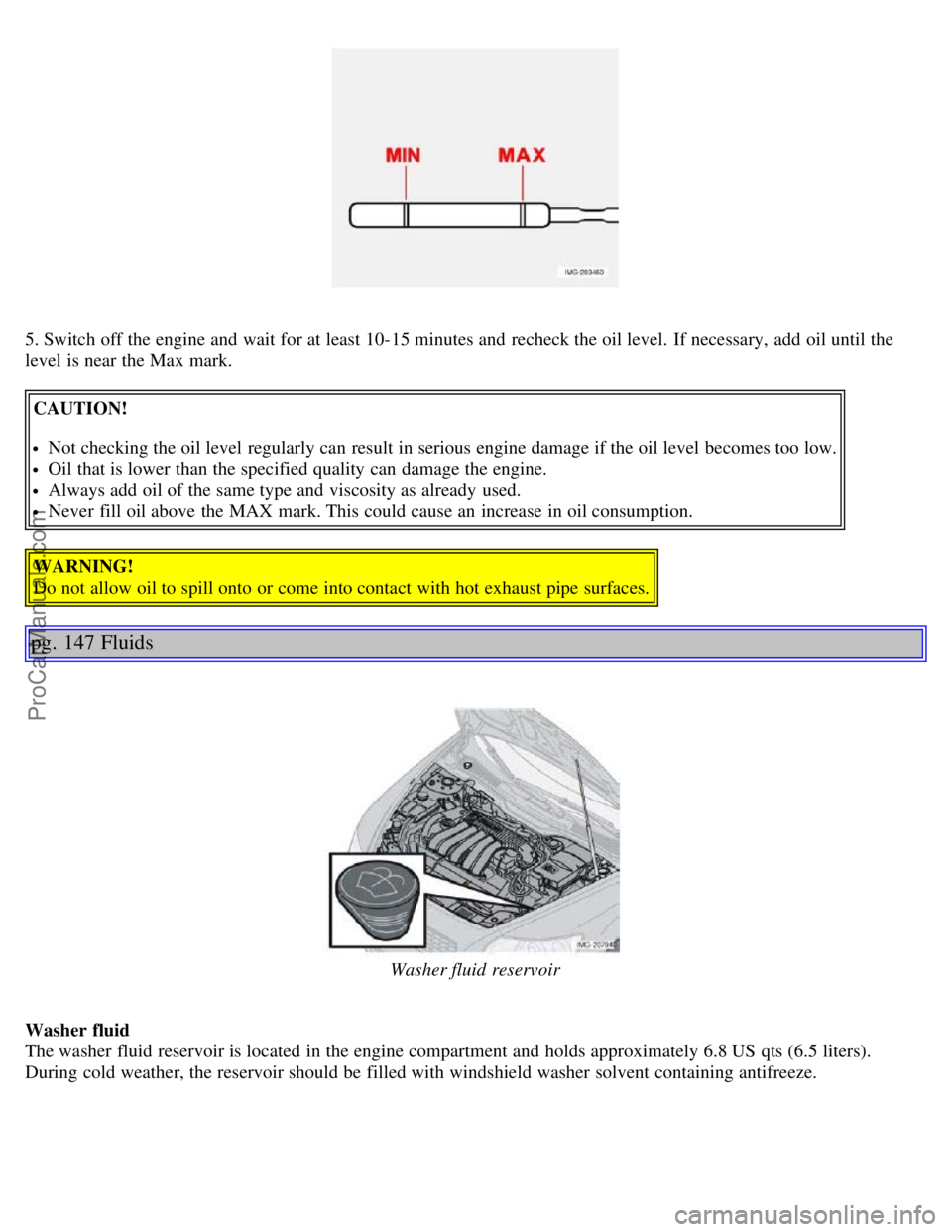
5. Switch off the engine and wait for at least 10-15 minutes and recheck the oil level. If necessary, add oil until the
level is near the Max mark.CAUTION!
Not checking the oil level regularly can result in serious engine damage if the oil level becomes too low.
Oil that is lower than the specified quality can damage the engine.
Always add oil of the same type and viscosity as already used.
Never fill oil above the MAX mark. This could cause an increase in oil consumption.
WARNING!
Do not allow oil to spill onto or come into contact with hot exhaust pipe surfaces.
pg. 147 Fluids
Washer fluid reservoir
Washer fluid
The washer fluid reservoir is located in the engine compartment and holds approximately 6.8 US qts (6.5 liters).
During cold weather, the reservoir should be filled with windshield washer solvent containing antifreeze.
ProCarManuals.com
Page 97 of 127
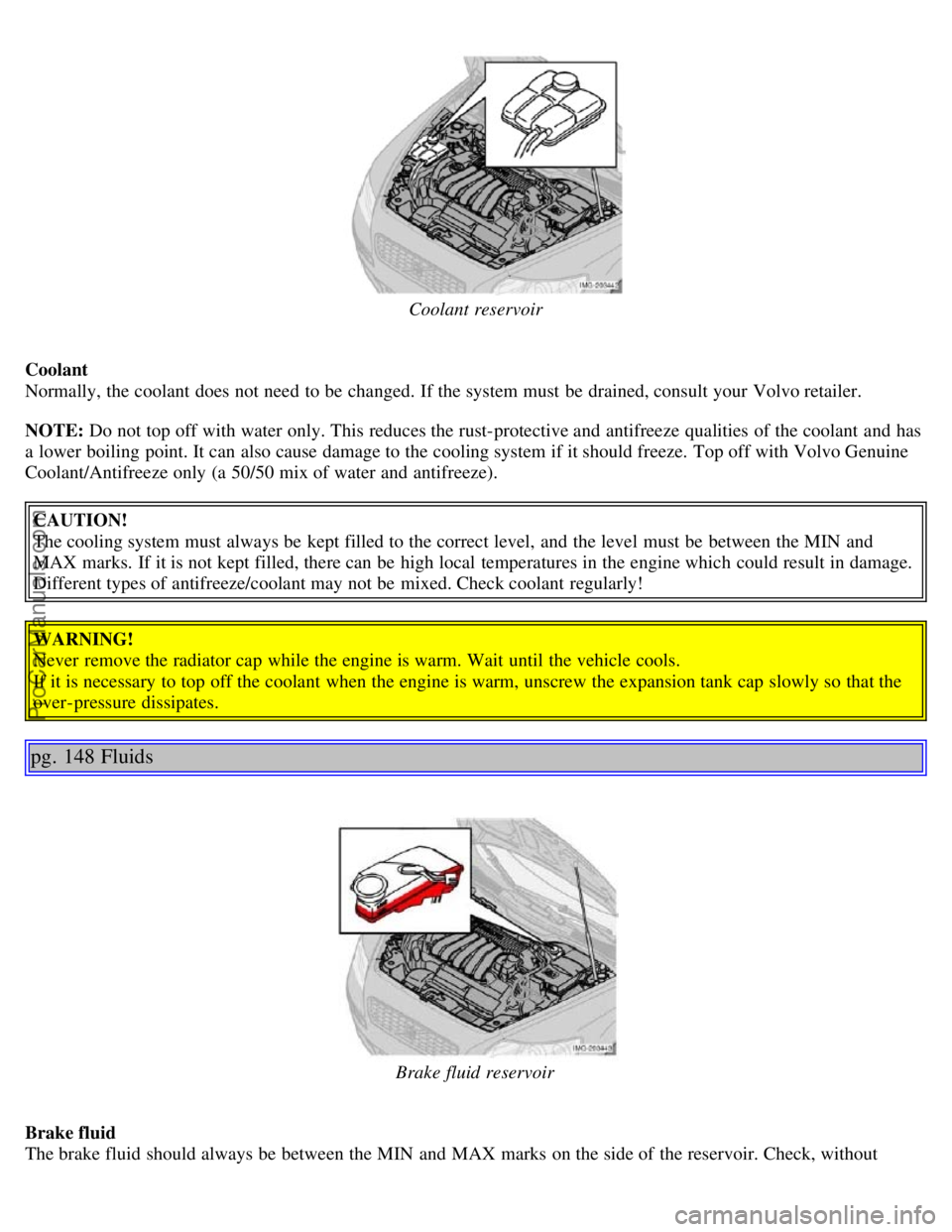
Coolant reservoir
Coolant
Normally, the coolant does not need to be changed. If the system must be drained, consult your Volvo retailer.
NOTE: Do not top off with water only. This reduces the rust-protective and antifreeze qualities of the coolant and has
a lower boiling point. It can also cause damage to the cooling system if it should freeze. Top off with Volvo Genuine
Coolant/Antifreeze only (a 50/50 mix of water and antifreeze). CAUTION!
The cooling system must always be kept filled to the correct level, and the level must be between the MIN and
MAX marks. If it is not kept filled, there can be high local temperatures in the engine which could result in damage.
Different types of antifreeze/coolant may not be mixed. Check coolant regularly!
WARNING!
Never remove the radiator cap while the engine is warm. Wait until the vehicle cools.
If it is necessary to top off the coolant when the engine is warm, unscrew the expansion tank cap slowly so that the
over-pressure dissipates.
pg. 148 Fluids
Brake fluid reservoir
Brake fluid
The brake fluid should always be between the MIN and MAX marks on the side of the reservoir. Check, without
ProCarManuals.com
Page 98 of 127
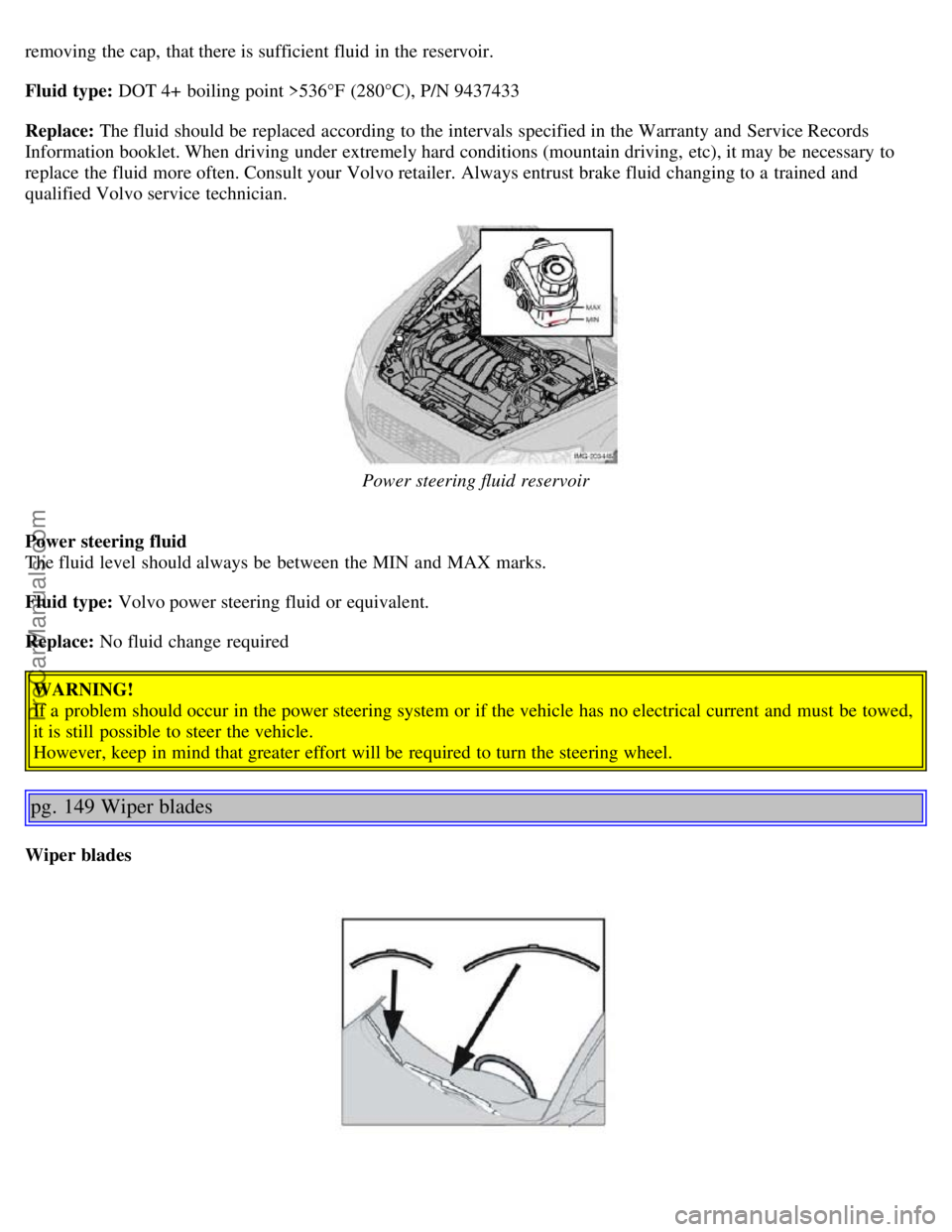
removing the cap, that there is sufficient fluid in the reservoir.
Fluid type: DOT 4+ boiling point >536°F (280°C), P/N 9437433
Replace: The fluid should be replaced according to the intervals specified in the Warranty and Service Records
Information booklet. When driving under extremely hard conditions (mountain driving, etc), it may be necessary to
replace the fluid more often. Consult your Volvo retailer. Always entrust brake fluid changing to a trained and
qualified Volvo service technician.
Power steering fluid reservoir
Power steering fluid
The fluid level should always be between the MIN and MAX marks.
Fluid type: Volvo power steering fluid or equivalent.
Replace: No fluid change required WARNING!
If a problem should occur in the power steering system or if the vehicle has no electrical current and must be towed,
it is still possible to steer the vehicle.
However, keep in mind that greater effort will be required to turn the steering wheel.
pg. 149 Wiper blades
Wiper blades
ProCarManuals.com
Page 100 of 127
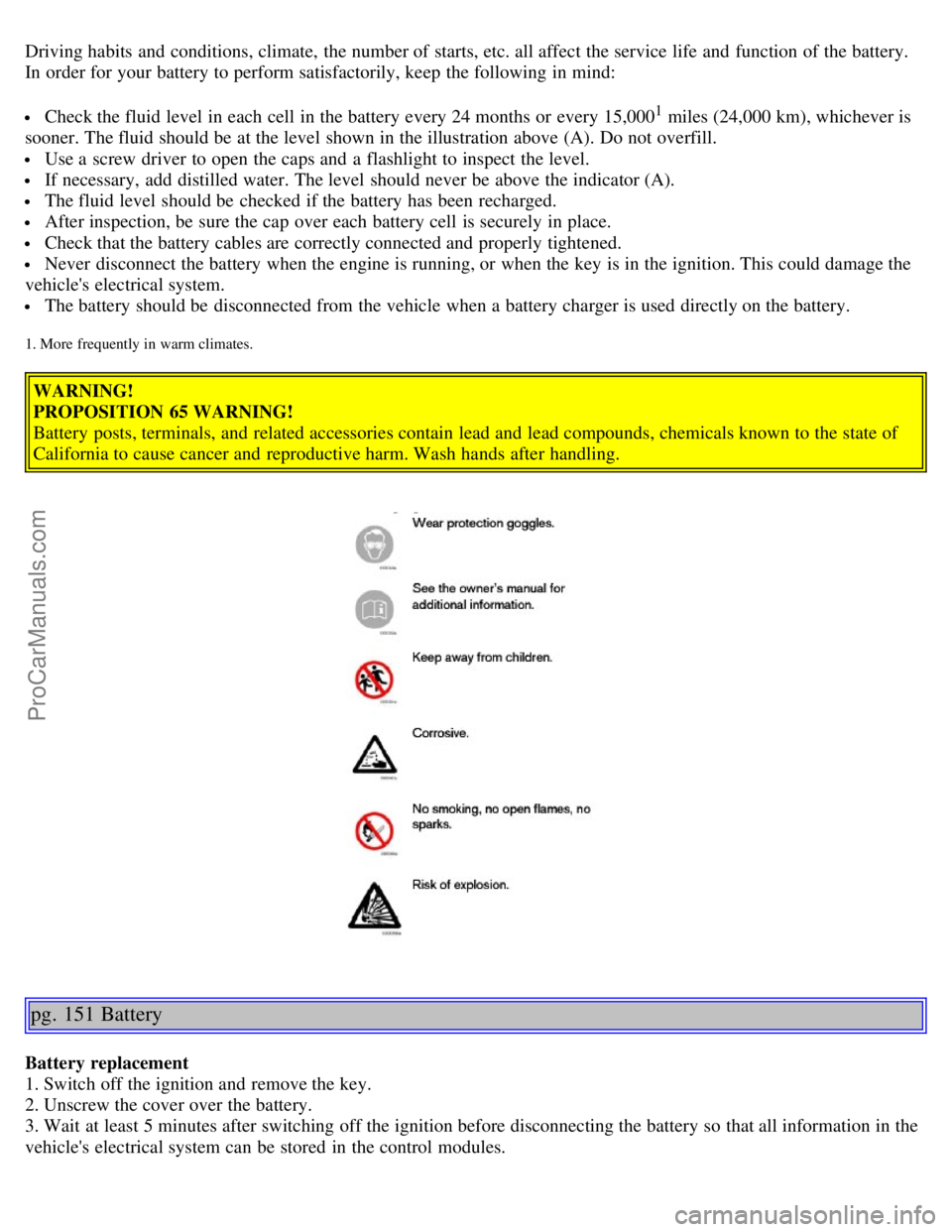
Driving habits and conditions, climate, the number of starts, etc. all affect the service life and function of the battery.
In order for your battery to perform satisfactorily, keep the following in mind:
Check the fluid level in each cell in the battery every 24 months or every 15,0001 miles (24,000 km), whichever is
sooner. The fluid should be at the level shown in the illustration above (A). Do not overfill.
Use a screw driver to open the caps and a flashlight to inspect the level.
If necessary, add distilled water. The level should never be above the indicator (A).
The fluid level should be checked if the battery has been recharged.
After inspection, be sure the cap over each battery cell is securely in place.
Check that the battery cables are correctly connected and properly tightened.
Never disconnect the battery when the engine is running, or when the key is in the ignition. This could damage the
vehicle's electrical system.
The battery should be disconnected from the vehicle when a battery charger is used directly on the battery.
1. More frequently in warm climates.
WARNING!
PROPOSITION 65 WARNING!
Battery posts, terminals, and related accessories contain lead and lead compounds, chemicals known to the state of
California to cause cancer and reproductive harm. Wash hands after handling.
pg. 151 Battery
Battery replacement
1. Switch off the ignition and remove the key.
2. Unscrew the cover over the battery.
3. Wait at least 5 minutes after switching off the ignition before disconnecting the battery so that all information in the
vehicle's electrical system can be stored in the control modules.
ProCarManuals.com
Page 101 of 127
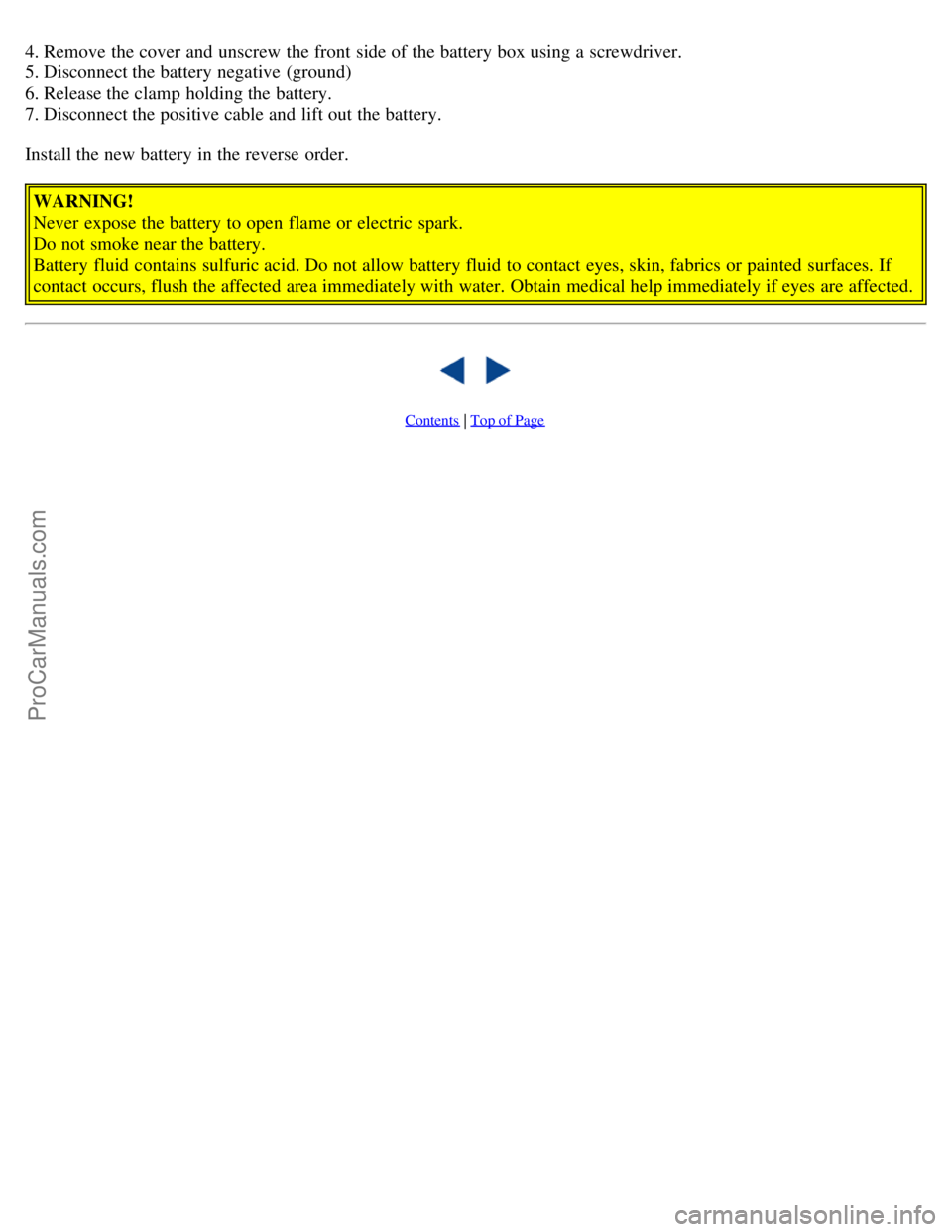
4. Remove the cover and unscrew the front side of the battery box using a screwdriver.
5. Disconnect the battery negative (ground)
6. Release the clamp holding the battery.
7. Disconnect the positive cable and lift out the battery.
Install the new battery in the reverse order.WARNING!
Never expose the battery to open flame or electric spark.
Do not smoke near the battery.
Battery fluid contains sulfuric acid. Do not allow battery fluid to contact eyes, skin, fabrics or painted surfaces. If
contact occurs, flush the affected area immediately with water. Obtain medical help immediately if eyes are affected.
Contents | Top of Page
ProCarManuals.com
Page 116 of 127
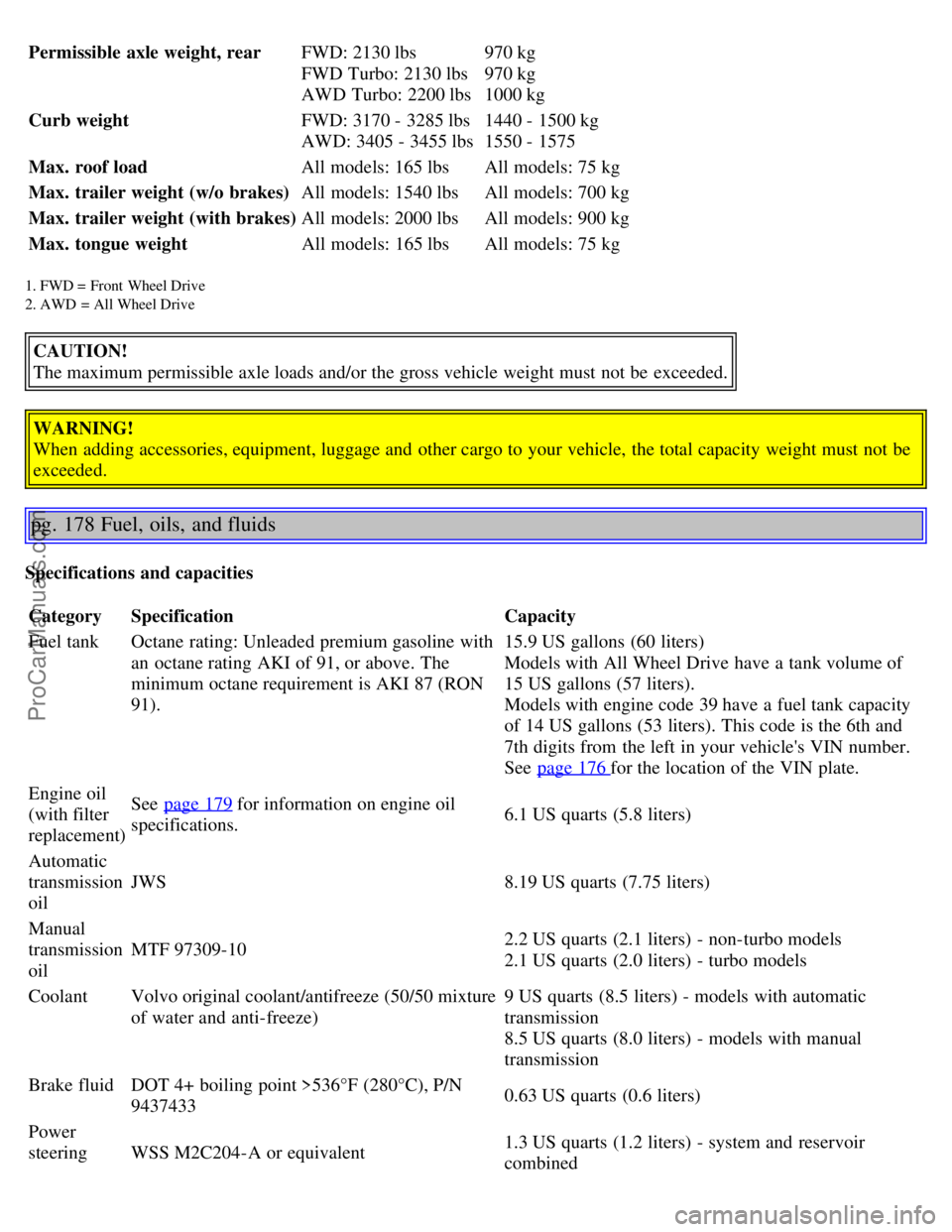
Permissible axle weight, rearFWD: 2130 lbs
FWD Turbo: 2130 lbs
AWD Turbo: 2200 lbs
970 kg
970 kg
1000 kg
Curb weight FWD: 3170 - 3285 lbs
AWD: 3405 - 3455 lbs1440 - 1500 kg
1550 - 1575
Max. roof load All models: 165 lbsAll models: 75 kg
Max. trailer weight (w/o brakes) All models: 1540 lbsAll models: 700 kg
Max. trailer weight (with brakes) All models: 2000 lbsAll models: 900 kg
Max. tongue weight All models: 165 lbsAll models: 75 kg
1. FWD = Front Wheel Drive
2. AWD = All Wheel Drive
CAUTION!
The maximum permissible axle loads and/or the gross vehicle weight must not be exceeded.
WARNING!
When adding accessories, equipment, luggage and other cargo to your vehicle, the total capacity weight must not be
exceeded.
pg. 178 Fuel, oils, and fluids
Specifications and capacities
Category Specification Capacity
Fuel tank Octane rating: Unleaded premium gasoline with
an octane rating AKI of 91, or above. The
minimum octane requirement is AKI 87 (RON
91). 15.9 US gallons (60 liters)
Models with All Wheel Drive have a tank volume of
15 US gallons (57 liters).
Models with engine code 39 have a fuel tank capacity
of 14 US gallons (53 liters). This code is the 6th and
7th digits from the left in your vehicle's VIN number.
See page 176
for the location of the VIN plate.
Engine oil
(with filter
replacement) See page 179
for information on engine oil
specifications. 6.1 US quarts (5.8 liters)
Automatic
transmission
oil JWS
8.19 US quarts (7.75 liters)
Manual
transmission
oil MTF 97309-10
2.2 US quarts (2.1 liters) - non-turbo models
2.1 US quarts (2.0 liters) - turbo models
Coolant Volvo original coolant/antifreeze (50/50 mixture
of water and anti-freeze) 9 US quarts (8.5 liters) - models with automatic
transmission
8.5 US quarts (8.0 liters) - models with manual
transmission
Brake fluid DOT 4+ boiling point >536°F (280°C), P/N
9437433 0.63 US quarts (0.6 liters)
Power
steering WSS M2C204-A or equivalent 1.3 US quarts (1.2 liters) - system and reservoir
combined
ProCarManuals.com
Page 122 of 127
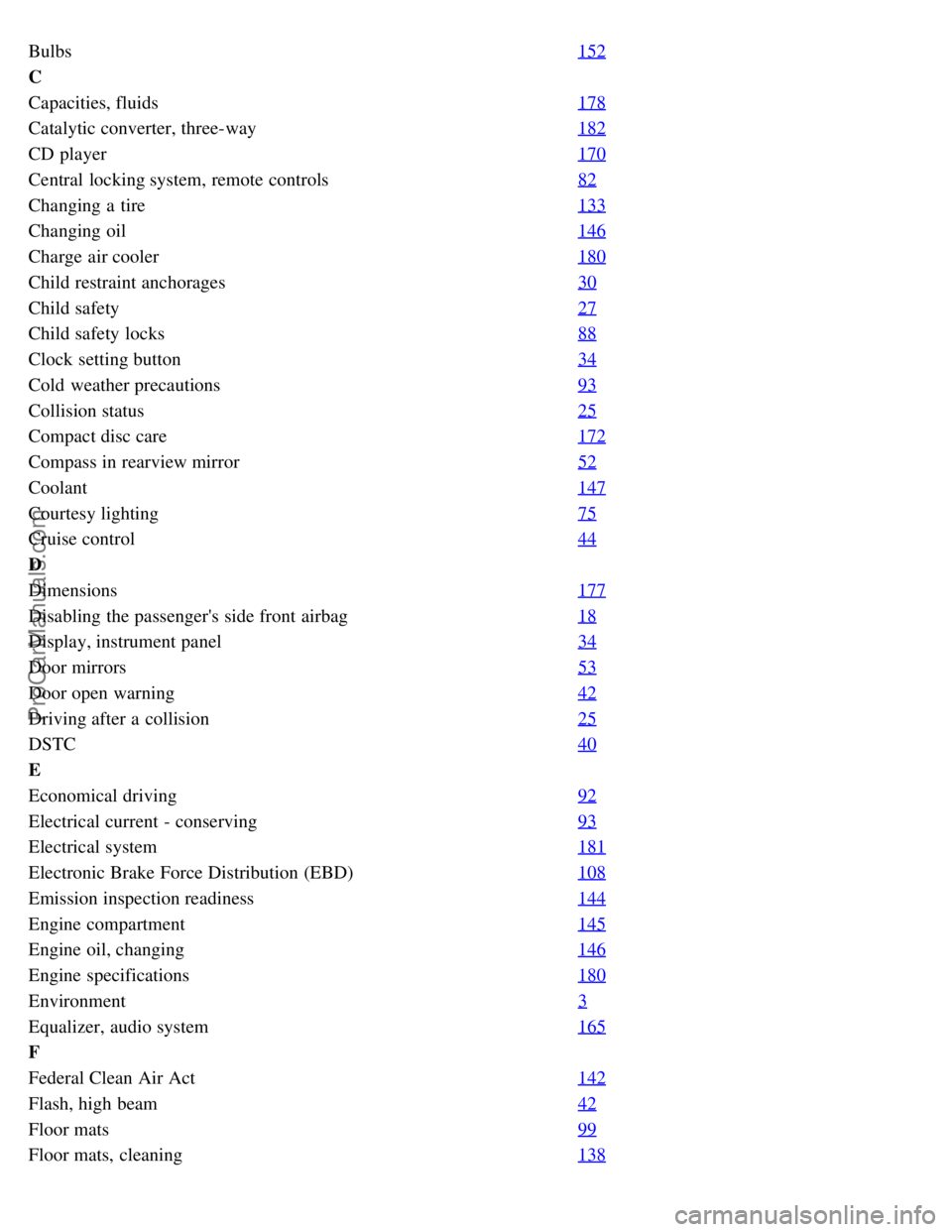
Bulbs152
C
Capacities, fluids178
Catalytic converter, three-way182
CD player170
Central locking system, remote controls82
Changing a tire133
Changing oil146
Charge air cooler180
Child restraint anchorages30
Child safety27
Child safety locks88
Clock setting button34
Cold weather precautions93
Collision status25
Compact disc care172
Compass in rearview mirror52
Coolant147
Courtesy lighting75
Cruise control44
D
Dimensions177
Disabling the passenger's side front airbag18
Display, instrument panel34
Door mirrors53
Door open warning42
Driving after a collision25
DSTC40
E
Economical driving92
Electrical current - conserving93
Electrical system181
Electronic Brake Force Distribution (EBD)108
Emission inspection readiness144
Engine compartment145
Engine oil, changing146
Engine specifications180
Environment3
Equalizer, audio system165
F
Federal Clean Air Act142
Flash, high beam42
Floor mats99
Floor mats, cleaning138
ProCarManuals.com
Page 123 of 127
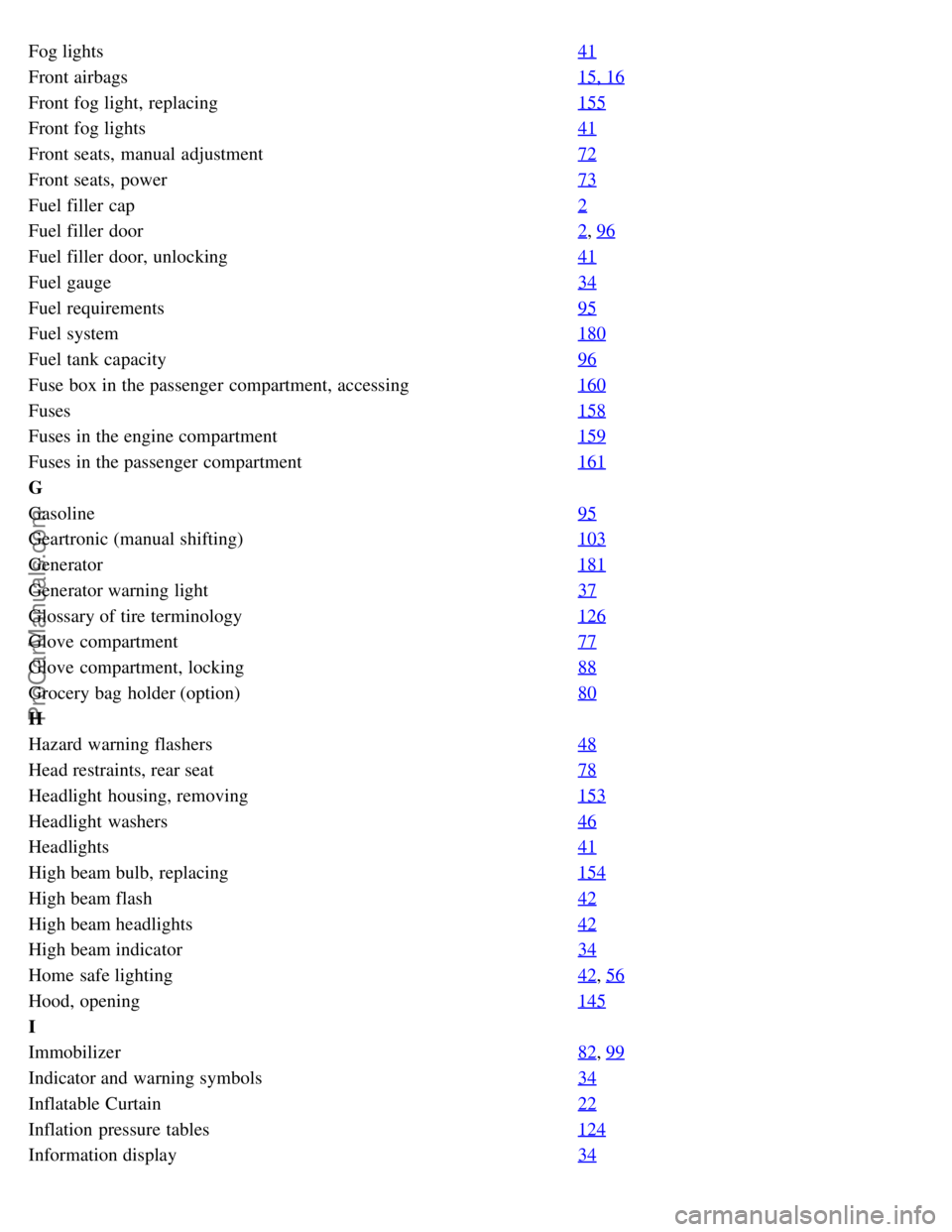
Fog lights41
Front airbags15, 16
Front fog light, replacing155
Front fog lights41
Front seats, manual adjustment72
Front seats, power73
Fuel filler cap2
Fuel filler door2, 96
Fuel filler door, unlocking41
Fuel gauge34
Fuel requirements95
Fuel system180
Fuel tank capacity96
Fuse box in the passenger compartment, accessing160
Fuses158
Fuses in the engine compartment159
Fuses in the passenger compartment161
G
Gasoline95
Geartronic (manual shifting)103
Generator181
Generator warning light37
Glossary of tire terminology126
Glove compartment77
Glove compartment, locking88
Grocery bag holder (option)80
H
Hazard warning flashers48
Head restraints, rear seat78
Headlight housing, removing153
Headlight washers46
Headlights41
High beam bulb, replacing154
High beam flash42
High beam headlights42
High beam indicator34
Home safe lighting42, 56
Hood, opening145
I
Immobilizer82
, 99
Indicator and warning symbols34
Inflatable Curtain22
Inflation pressure tables124
Information display34
ProCarManuals.com
Page 124 of 127
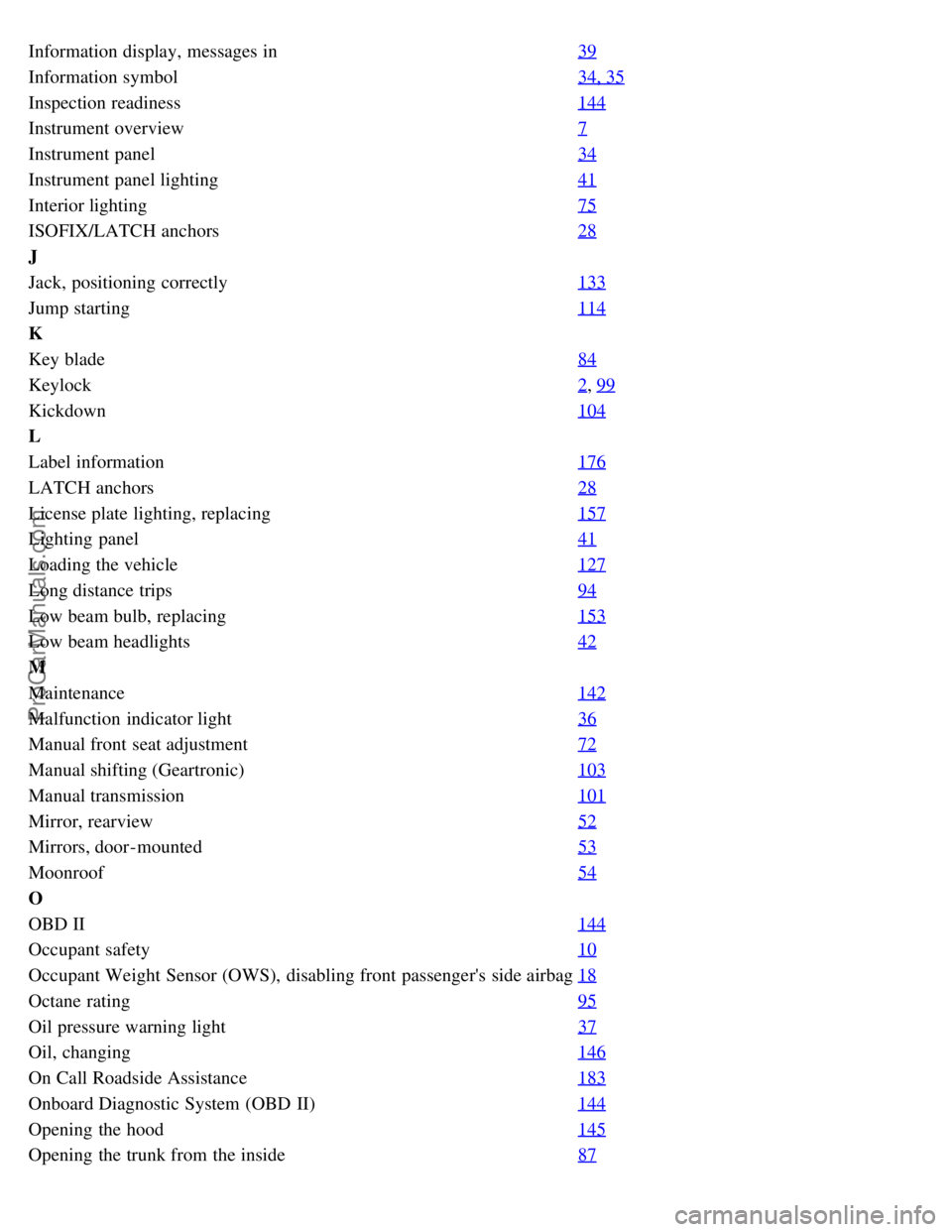
Information display, messages in39
Information symbol34, 35
Inspection readiness144
Instrument overview7
Instrument panel34
Instrument panel lighting41
Interior lighting75
ISOFIX/LATCH anchors28
J
Jack, positioning correctly133
Jump starting114
K
Key blade84
Keylock2, 99
Kickdown104
L
Label information176
LATCH anchors28
License plate lighting, replacing157
Lighting panel41
Loading the vehicle127
Long distance trips94
Low beam bulb, replacing153
Low beam headlights42
M
Maintenance142
Malfunction indicator light36
Manual front seat adjustment72
Manual shifting (Geartronic)103
Manual transmission101
Mirror, rearview52
Mirrors, door-mounted53
Moonroof54
O
OBD II144
Occupant safety10
Occupant Weight Sensor (OWS), disabling front passenger's side airbag18
Octane rating95
Oil pressure warning light37
Oil, changing146
On Call Roadside Assistance183
Onboard Diagnostic System (OBD II)144
Opening the hood145
Opening the trunk from the inside87
ProCarManuals.com
Page 125 of 127
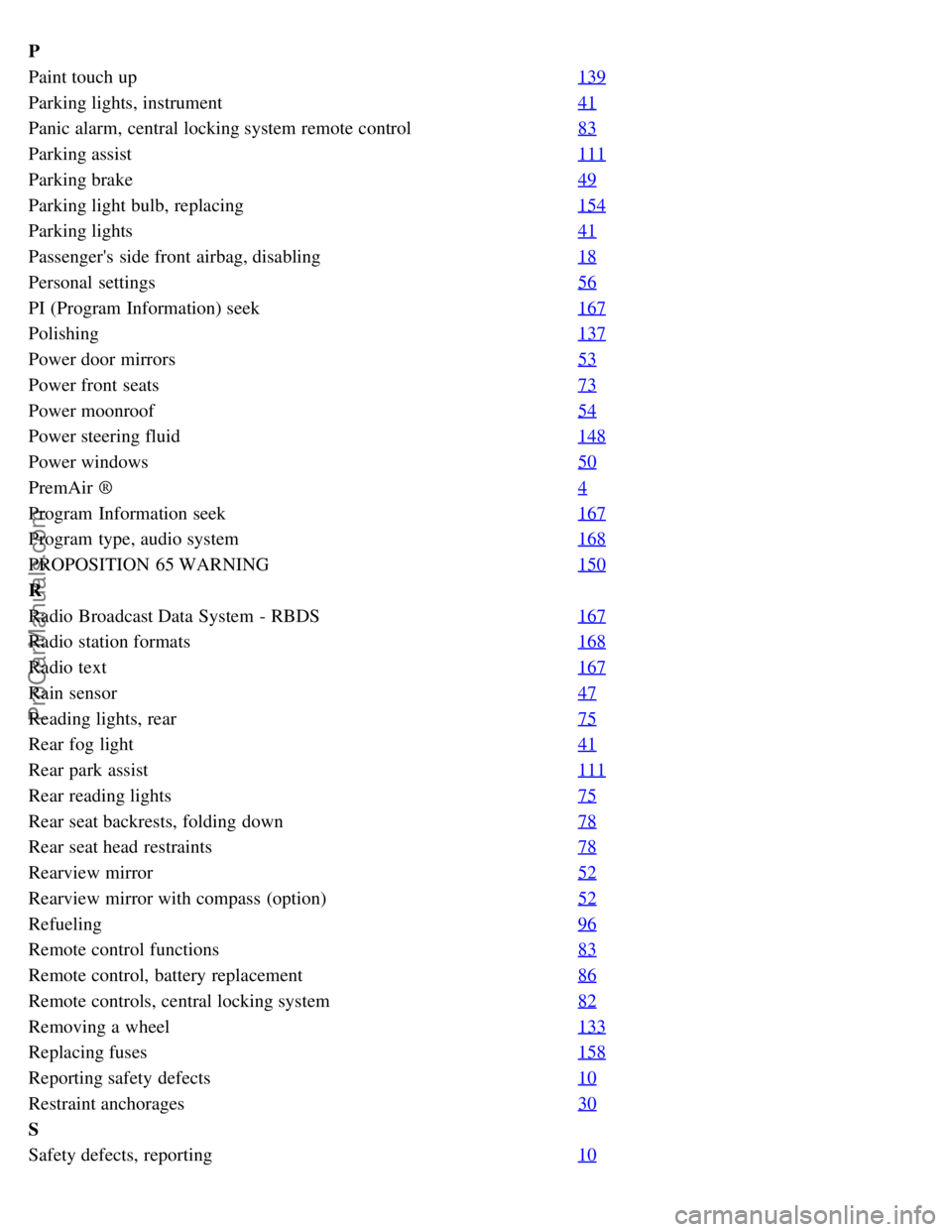
P
Paint touch up139
Parking lights, instrument41
Panic alarm, central locking system remote control83
Parking assist111
Parking brake49
Parking light bulb, replacing154
Parking lights41
Passenger's side front airbag, disabling18
Personal settings56
PI (Program Information) seek167
Polishing137
Power door mirrors53
Power front seats73
Power moonroof54
Power steering fluid148
Power windows50
PremAir ®4
Program Information seek167
Program type, audio system168
PROPOSITION 65 WARNING150
R
Radio Broadcast Data System - RBDS167
Radio station formats168
Radio text167
Rain sensor47
Reading lights, rear75
Rear fog light41
Rear park assist111
Rear reading lights75
Rear seat backrests, folding down78
Rear seat head restraints78
Rearview mirror52
Rearview mirror with compass (option)52
Refueling96
Remote control functions83
Remote control, battery replacement86
Remote controls, central locking system82
Removing a wheel133
Replacing fuses158
Reporting safety defects10
Restraint anchorages30
S
Safety defects, reporting10
ProCarManuals.com